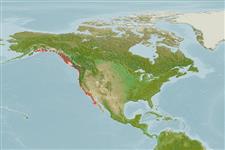Environment: milieu / climate zone / depth range / distribution range
Écologie
marin démersal; profondeur ? - 30 m (Ref. 2850). Subtropical; 61°N - 20°N, 154°W - 114°W
Eastern Pacific: northern British Columbia, Canada to central Baja California, Mexico, including Guadalupe Island, off north central Baja California.
Taille / Poids / Âge
Maturity: Lm ? range ? - ? cm
Max length : 22.0 cm TL mâle / non sexé; (Ref. 2850)
Description synthétique
Clés d'identification | Morphologie | Morphométrie
Épines dorsales (Total) : 7 - 9; Rayons mous dorsaux (Total) : 13 - 16; Épines anales: 3; Rayons mous anaux: 21 - 24; Vertèbres: 31 - 34. Color variable, olive brown to coppery above lateral line, with dark pigment under each scale, bright below lateral line; dark on axil; fins either pale or rosy (Ref. 6885).
Found among giant kelp, usually up in kelp canopy. Feed on small crustaceans, especially ones that live on kelp. Also a cleaner which picks external parasites from other fishes. Usually occur in large aggregations in summer (Ref. 2850). Viviparous, female carries the developing young (Ref. 205).
Life cycle and mating behavior
Maturité | Reproduction | Frai | Œufs | Fécondité | Larves
Viviparous, female carries the developing young (Ref. 205).
Eschmeyer, W.N., E.S. Herald and H. Hammann, 1983. A field guide to Pacific coast fishes of North America. Boston (MA, USA): Houghton Mifflin Company. xii+336 p. (Ref. 2850)
Statut dans la liste rouge de l'IUCN (Ref. 130435: Version 2024-1)
Menace pour l'homme
Harmless
Utilisations par l'homme
Pêcheries: commercial; Aquarium: Aquariums publics
Outils
Articles particuliers
Télécharger en XML
Sources Internet
Estimates based on models
Preferred temperature (Ref.
123201): 8.4 - 18.3, mean 10.7 °C (based on 229 cells).
Phylogenetic diversity index (Ref.
82804): PD
50 = 0.7500 [Uniqueness, from 0.5 = low to 2.0 = high].
Bayesian length-weight: a=0.01318 (0.00547 - 0.03178), b=3.05 (2.84 - 3.26), in cm total length, based on LWR estimates for this (Sub)family-body shape (Ref.
93245).
Niveau trophique (Ref.
69278): 3.5 ±0.50 se; based on food items.
Résilience (Ref.
120179): Haut, temps minimum de doublement de population inférieur à 15 mois (tm=1).
Fishing Vulnerability (Ref.
59153): Low vulnerability (12 of 100).
Nutrients (Ref.
124155): Calcium = 155 [85, 298] mg/100g; Iron = 1.43 [0.91, 2.36] mg/100g; Protein = 19.1 [18.3, 20.0] %; Omega3 = 0.368 [0.238, 0.576] g/100g; Selenium = 20.5 [11.1, 39.0] μg/100g; VitaminA = 13.1 [4.8, 35.6] μg/100g; Zinc = 0.956 [0.691, 1.351] mg/100g (wet weight);
